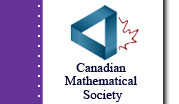December, 2020
- Math Central (MC):
-
Can you tell us your job title and who is your employer?
- ANTHONY:
-
I’m a full professor at Ryerson University in Toronto, and served there as Department Chair and Associate Dean in Graduate Studies.
- MC:
-
How would you describe your job?
- ANTHONY:
-
When I visited Virginia Commonwealth University on my last sabbatical, I spoke at the Sonya Kovalevsky Mathematics Day aimed at young women in Grades 6 to 8. My first question to them was: what do mathematicians do? A student’s simple response stuck with me: “you do math.” That’s almost spot on. As a professional mathematician, I spend my days discovering new math. I also mentor the next generation of mathematicians as graduate students and post-docs, and I enjoy teaching the topic to undergraduate and graduate students.
My research expertise is in network science and graph theory, and my two areas of focus are complex networks and graph searching. Networks are as fundamental as numbers; they quantify interactions between objects and are an essential tool to describe systems in nature.
Complex networks appear everywhere, ranging from social networks like Twitter and Instagram, to Bitcoin transactions, to interactions between proteins in living cells. I’m interested in the mining and modelling of big data extracted from these networks, with the goals of predicting their structure and evolution. While much of this work is theoretical, using tools from probability and geometry, there are many concrete applications such as finding trends in networks of Twitter keywords or predicting leaders and alliances in game shows like Survivor.
In graph searching, an intruder loose on a network that pursuers attempt to capture, neutralize, or contain. The intruder can be invisible, leaving clues about their location, or visible but navigating through a complicated terrain. Such problems have applications to driverless cars and are part of the larger area of mobile computing. My work in graph searching focuses on minimizing the number of pursuers needed to find intruders on networks, as is the case with combinatorial games such as Cops and Robbers. These questions quickly lead to deep mathematical problems such as Meyniel’s conjecture on networks.
- MC:
Tell us a little about your background and education.
- ANTHONY:
I grew up in a small town in Ontario, and I was lucky enough to have a family who encouraged my intellectual pursuits. I completed my doctorate at the University of Waterloo in 1998, and I’ve been a university professor for twenty-two years.
I’m a full professor at Ryerson University in Toronto, and served there as Department Chair and Associate Dean in Graduate Studies. As an openly gay man, I’ve experienced barriers and discrimination because of my identity inside and outside the academy, and one of my goals is to help make math more inclusive.
LGBTQ+ mathematicians face a scarcity of representation in the academy and the mathematical community, and Iím proud to be making a difference on this front. I recently organized the first-ever conference in Canada celebrating the life and work of LGBTQ+ mathematicians. While much progress is happening, there is more work to make our subject genuinely inclusive.
- MC:
When did you decide to make a career of mathematics?
- ANTHONY:
I’m a believer in following your passion, and mathematics was mine since I was a teenager. Not only was I good at it, but I found mathematics infinitely fascinating: for every question you answer, there are another two questions that appear. You don’t need chemistry labs, billion dollar particle colliders, or quantum computers to discover new mathematical vistas. All you need is a pen and paper or board and chalk, and an open mind.
The more abstract mathematics became, the more I was drawn to it. Paradoxically, much of the mathematics I do now is highly applicable to fields such as computer science.
- MC:
-
What are your hobbies and other interests? What do you do when you are not doing mathematics?
- ANTHONY:
-
Writing is a passion of mine, and I’ve authored four books and over 120 research papers. I’ve maintained a popular blog about math in pop culture for several years. My popular math writing has appeared in places like The Conversation, The Mathematical Intelligencer, and picked up by various news outlets.

